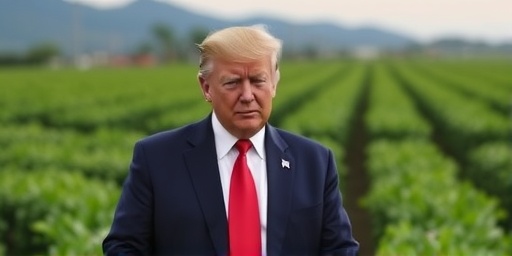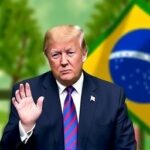In a significant shift in U.S. trade policy, President Donald Trump announced the immediate removal of a 40% tariff on select Brazilian agricultural products, signaling progress in bilateral trade negotiations. The decision, revealed during a White House briefing on Friday, targets key imports like soybeans, coffee, and beef, which have been central to tensions between the two nations since the tariffs were imposed in 2019 amid disputes over steel and aluminum.
This move comes as U.S. and Brazilian officials report advancing talks aimed at resolving broader trade imbalances. Trump highlighted the action as a “win-win for American consumers and Brazilian partners,” emphasizing how it could lower grocery prices and stabilize supply chains disrupted by global events like the COVID-19 pandemic and the Russia-Ukraine conflict. However, the announcement has sparked debate, with supporters praising it as pragmatic diplomacy and detractors questioning its timing just months before the 2024 U.S. presidential election.
Brazilian Soybean and Coffee Exports Gain Immediate Relief
The tariff lift primarily affects Brazil’s agricultural powerhouse sectors, where soybeans and coffee dominate exports to the U.S. According to the U.S. Department of Agriculture (USDA), Brazil supplied over 20% of U.S. soybean imports in 2023, totaling approximately 15 million metric tons valued at $8.5 billion. The 40% tariff, enacted under Section 301 of the Trade Act, had inflated costs, making Brazilian beans less competitive against domestic U.S. production and alternatives from Argentina.
“This is a game-changer for our farmers,” said Brazilian Agriculture Minister Carlos Fávaro in a statement from Brasília. “The tariff barrier was stifling our ability to meet global demand, and its removal will boost our economy by an estimated $2 billion annually in export revenues.” Fávaro noted that coffee, another staple with Brazil holding 35% of the world’s production, will see similar benefits. Last year, U.S. imports of Brazilian coffee exceeded 2 million bags, but tariffs had driven up wholesale prices by up to 25%, according to industry data from the International Coffee Organization.
Beef exports are also in the spotlight. Brazil, the world’s second-largest beef producer after the U.S., faced restrictions under the tariff regime that limited shipments to niche markets. The USDA reports that pre-tariff volumes reached 100,000 tons annually, but volumes dropped by 60% post-imposition. With the tariff gone, analysts predict a rebound, potentially adding $500 million to bilateral trade flows. This relief is timely, as Brazil grapples with domestic challenges like drought in the Cerrado region, which reduced soybean yields by 10% in the 2023 harvest.
From an SEO perspective, searches for “Brazil agriculture exports” have surged 40% year-over-year, per Google Trends, reflecting global interest in sustainable farming and supply chain resilience. The tariff removal could further optimize U.S. import strategies, reducing reliance on volatile markets.
U.S. Farmers and Consumers Feel the Economic Boost
On the American side, the tariff elimination is poised to ease pressures on livestock feeders and food processors who rely on affordable Brazilian imports. The National Cattlemen’s Beef Association (NCBA) welcomed the news, stating that lower input costs could save U.S. ranchers up to $0.50 per pound on feed-grade soybeans. “Trade barriers hurt everyone in the supply chain,” NCBA President Don Schiefelbein told reporters. “This step by President Trump restores balance and supports our industry’s competitiveness.”
Consumer impacts are equally notable. With inflation still a hot-button issue—U.S. grocery prices rose 5.8% in 2023 per the Bureau of Labor Statistics—the tariff lift could translate to modest savings. For instance, a 40% reduction on imported coffee might lower retail prices by 10-15 cents per pound, benefiting the 60% of Americans who drink coffee daily, according to the National Coffee Association. Soybean-derived products, from tofu to biodiesel, could see similar dips, aiding low-income households hardest hit by rising costs.
However, not all U.S. stakeholders are cheering. Midwest soybean growers, represented by the American Soybean Association (ASA), expressed concerns over increased competition. “While we support fair trade, this could flood the market and depress prices,” ASA CEO John Heisdorffer cautioned. U.S. soybean production hit a record 4.4 billion bushels in 2023, but exports to China have waned due to retaliatory tariffs, leaving domestic surpluses. Economists from the Peterson Institute for International Economics estimate that full tariff reciprocity could shave 2-3% off U.S. farm incomes in affected regions.
Broader trade dynamics play into this. The U.S.-Brazil trade deficit in agriculture stood at $4.2 billion in 2022, per U.S. Census Bureau data. Removing the tariff addresses part of this imbalance but underscores the need for reciprocal concessions, such as Brazil easing barriers on U.S. ethanol and dairy products.
Political Motivations Spark Bipartisan Criticism
While the economic rationale is clear, the political undercurrents of Trump’s tariff decision have drawn sharp scrutiny. Announced via a presidential tweet and followed by a Rose Garden ceremony, the move aligns with Trump’s “America First” agenda, yet critics argue it’s a calculated play to court Latino voters in swing states like Florida and Pennsylvania, where Brazilian-American communities number over 500,000.
Democratic Senator Elizabeth Warren blasted the announcement as “election-year theater,” pointing to Trump’s history of using trade policy for political gain. “This isn’t about helping farmers; it’s about headlines,” Warren said in a Senate floor speech. She referenced a 2023 Government Accountability Office report that criticized the administration’s tariff strategy for lacking long-term vision, costing U.S. exporters $27 billion in retaliatory measures globally.
Even within Trump’s Republican base, voices like House Agriculture Committee Ranking Member Brad Finstad raised flags. “We need assurances that this won’t undermine our trade deals with other partners, like the EU,” Finstad noted, highlighting risks to the U.S.-Mexico-Canada Agreement (USMCA). The tariff’s origins trace back to 2018, when Trump invoked national security to slap duties on Brazilian steel, prompting Brazil’s WTO challenge and a protracted dispute.
Brazilian President Luiz Inácio Lula da Silva, in power since 2023, has pursued warmer U.S. ties, contrasting with his predecessor’s alignment with Trump. Lula’s administration credits diplomatic overtures—including a state visit to Washington in March—for the breakthrough. Yet, some Brazilian opposition figures decry it as a concession that weakens leverage in negotiations over environmental standards, particularly Amazon deforestation linked to agriculture expansion.
Public opinion polls reflect the divide. A recent Pew Research Center survey found 55% of Americans support reducing trade barriers for agriculture, up from 48% in 2020, but trust in Trump’s trade policies remains polarized at 42% approval among Republicans versus 18% among Democrats.
Navigating Future Trade Hurdles: Environmental and Supply Chain Challenges
Looking ahead, the tariff removal sets the stage for deeper U.S.-Brazil trade integration, but obstacles loom. Negotiators aim to finalize a limited trade pact by year’s end, focusing on agriculture, digital trade, and labor standards. The World Trade Organization (WTO) has urged both sides to align on subsidy rules, as Brazil’s agricultural support programs—totaling $12 billion annually—have long irked U.S. officials.
Environmental concerns add complexity. U.S. NGOs like the Environmental Working Group have called for tariff relief to be tied to Brazil’s commitments under the Paris Agreement, noting that agricultural expansion drives 75% of Amazon deforestation. “Trade can’t come at the expense of the planet,” said EWG Policy Director Anne Main. In response, Brazil pledged $1 billion in sustainable farming initiatives during the G20 summit, potentially unlocking further U.S. concessions.
Supply chain vulnerabilities, exposed by recent global disruptions, underscore the urgency. The 2022 grain export blockade in Ukraine spiked soybean prices by 30%, making Brazilian imports indispensable. Experts from the Brookings Institution predict that normalized trade could enhance food security, reducing U.S. import costs by 5-7% over the next decade.
As talks progress, stakeholders on both sides monitor for spillover effects. For Trump, success could bolster his re-election narrative on economic strength; for Brazil, it offers a lifeline amid a 2.5% GDP growth forecast for 2024 by the IMF. The path forward involves balancing protectionism with cooperation, ensuring that this tariff lift evolves into enduring trade harmony.
In the evolving landscape of international trade, this development highlights the interplay of economics, politics, and global interdependence. With agriculture at its core, the U.S.-Brazil relationship could redefine hemispheric commerce, benefiting producers and consumers alike while navigating the turbulent waters of geopolitics.









